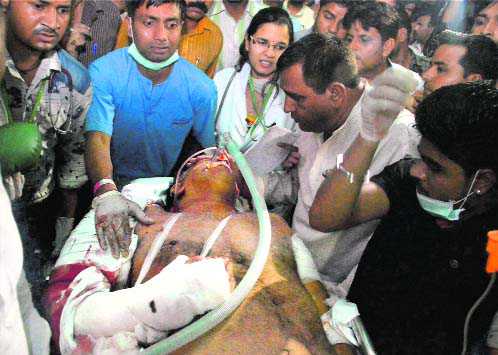August 11, 2016: An influential BJP leader, Brijpal Teotia, along with five others was shot at in a suburb of Ghaziabad, western Uttar Pradesh. Senior superintendent of police KS Emmanuel said two of the assailants fled under cover of darkness despite heavy police deployment. The two left behind a sports bag containing an AK-47, two magazines and two pistols. Days after investigation, the police dug out a 17-year-old property dispute and described the incident as a revenge attack for a murder that took place in 1999.
Jan 26, 2017: A local politician, an eyewitness in his son’s murder case, was shot at in Muzaffarnagar when he refused to withdraw the case. Shobharam Arya (60) was shifted to a hospital in a serious condition. His son Omvir was murdered in 2014 and Arya was being pressured to withdraw the case.
These and over a dozen such cases in the last four years in western Uttar Pradesh, called the Wild West of north India, point to a stark reality of the state (polls due in seven phases beginning Feb 11 till March 8). The mafia-style murders take place in a land famous for its fertile tracts and sugarcane cultivation. The Gangetic plain is stretched across Ghaziabad, Baghpat, Meerut, Muzaffarnagar, Saharanpur and Bijnore. The land is notoriously violent with kidnappings, political murders, gang-wars becoming a routine.
The soil of the area has set the economic pattern in the region and has a lot do with the rising crime graph. In the last three decades, several gangs have ruled the socio-economic and political scene of the region. Caste and religious affiliations have played important roles in nurturing the organized crime.
Political analyst and social worker Jitendra Dikshit, who is based out in Muzaffarnagar, says from Meerut to Haridwar (Uttarakhand), the rich soil provides fortunes to farmers to grow sugarcane -- over 70% of farmland is used for growing the crop. “Sugarcane is less labour-intensive with high returns. This leaves farmers with more income. Freer time with surplus cash provides for a perfect platform to run a parallel system.”
A former journalist of a Hindi daily of the region says during his tenure in the late 90s, a reporter had broken a story citing a confidential letter written by then District Magistrate of Muzaffarnagar Vinod Shankar Chowbey to the state home department. The DM advised serious vetting of entrenched caste affiliations of Jats and Muslims before recruiting their men in the police force. He had in his letter feared breach of confidentiality of police actions. “Following the report in the newspaper, the government immediately transferred him.”
For long criminal-police nexus has also provided a perfect fodder for mainly kidnappers as dense sugarcane farms are a perfect hiding place, where a victim can easily be confined and ransom collected.
The criminal elements among dominant castes initially led such gangs. From year 2000 onwards, a few Muslim gang leaders also came to the fore, said Dikshit. Most such criminals have been land owners and their victims ‘Ahartiyas (middlemen)’ belonging to traders community, who worked as a link between big sugar mills and farmers.
What started as a reaction against perceived exploitation by Ahartiyas gradually turned into violent reprisals, acquiring the ‘status’ of industry. With surplus money, it was easy for the gang lords to arrange modern weapons. An officer posted in a rural police station of Meerut district claimed that most of these gangs have automatic weapons, which the state police at times fail to match.
In recent times, the crime world in the region has been witnessing a metamorphic change, as several gang leaders with plenty of land have joined politics. Large-scale highway and industrial expansion has fetched lucrative land prices. “The criminal elements have become land dealers. They make huge money out of it. Once substantial wealth is acquired, they turn to electoral politics,” said Dikshit.
A National Crime Research Bureau’s data for 2015 points out that Uttar Pradesh still tops the chart in kidnapping cases (11,999) of which more than half were reported from western UP. Agra (339), Ghaziabad (315) and Meerut (129) topped the state list. Interestingly, out of the total reported cases, 69% were related to kidnapping of women for forcing them into marriage.
Unlock Exclusive Insights with The Tribune Premium
Take your experience further with Premium access.
Thought-provoking Opinions, Expert Analysis, In-depth Insights and other Member Only Benefits
Already a Member? Sign In Now











